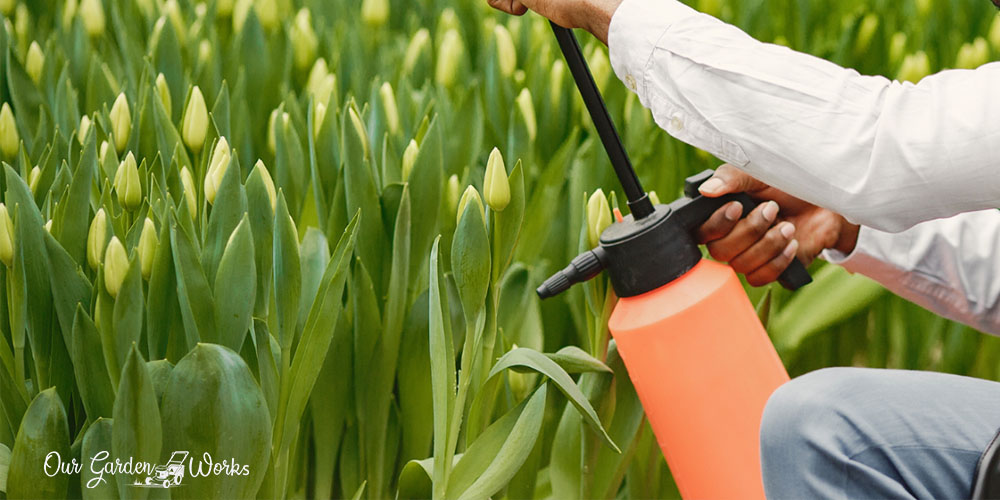If you’ve been reading about tulip growing, you probably know that they don’t like wet feet. However, water helps the bulbs wake up from their cold slumber and keep them stable. So the next question is, how often do you water tulips? Well, the answer to that is beyond a simple yes or no.
A tulip plant is a low-maintenance plant that produces one of the most beautiful blooms. Though it’s temperature-sensitive and a lot of work to keep indoors, seeing it bloom is worth the time and effort.
In this post, we will share the relationship of tulips with water and how tulips can be very sensitive to moisture and temperature.
Q: How Often Do You Water Tulips?
Rainy weather and frequent watering can kill tulips. You only need to water them during planting and when there’s a threat of drought stress before the ground freezes. The ideal water level in watering tulips is ⅔ of an inch per plant.
When watering tulips, the moisture reaches the bottom of the pot to achieve better results. The watering method should be soil drench because overhead watering can increase the risk for the development of fungal disease.
The approach to watering also varies depending on where the tulips are planted. Check out how you should water your tulips in containers and in-ground.
In-ground Watering
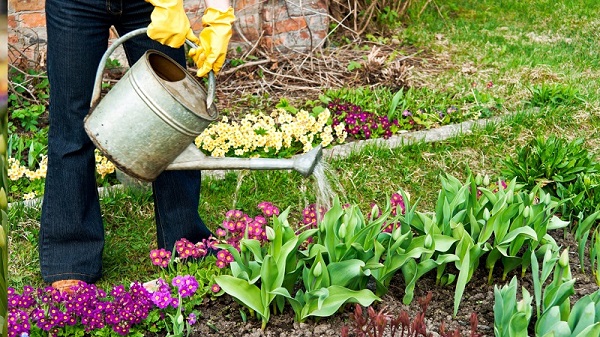
The ground soil can retain more water so it’s important that you only water your in-ground tulips briefly or not at all. Avoid overhead watering or letting water droplets fall on the leaves to keep pests and bacterial infections at bay.
Below is an example of Botrytis blight on the tulip flower caused by overhead irrigation.
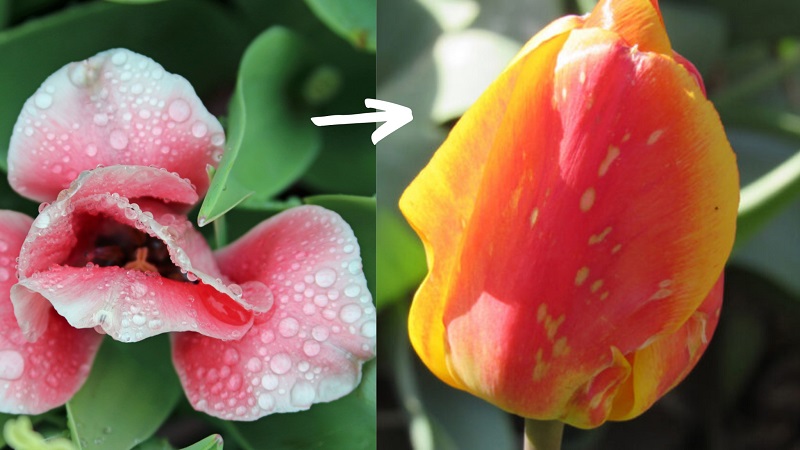
Plant your tulips away from irrigation systems like sprinklers and drip systems to help them thrive. Unlike other flowering plants, tulips are prone to root rot due to prolonged exposure to standing water.
If you live in rainy and snowy states, you no longer need to water your tulips. You only have to ensure that the soil is well-draining. You can improve the soil drainage by mixing sand or wood barks in the ground soil.
Pot Watering
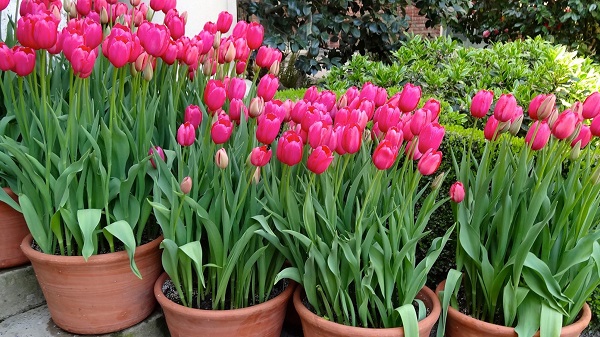
Potted tulips are more prone to drought stress because potting soils and drainage holes in the pots speed up soil drainage. Water them sparingly only if the soil has become too dry. Unlike in-ground tulips, the enclosed environment of pots can also cause overwatering issues and rot the bulbs in the soil.
Here are some tips that you should observe when watering potted tulips:
- After watering the tulip plants, let the water drip for 30 minutes. Once all the water is drained, remove the accumulated water from the dripping pan.
- If you are forcing your potted tulips indoors, you need to water them after placing them in cold storage for 12 weeks. The water will help the bulbs wake up from months of slumber and begin growing roots, leaves, and flowers.
Factors That May Affect Your Tulip Watering Routine
The resilient tulip planted outdoors will have to deal with climate changes that can affect your watering routine. Here are the weather conditions that you should observe before watering your tulips outdoors.
Snow
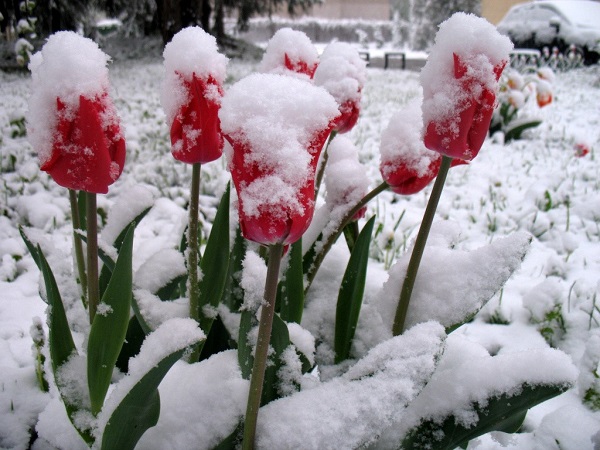
Tulips are unbothered by the freezing temperatures of winter and dropping temperatures at night. The cold is the tulip’s best friend. It helps them grow beautiful flowers in spring and water them naturally (so you won’t have to).
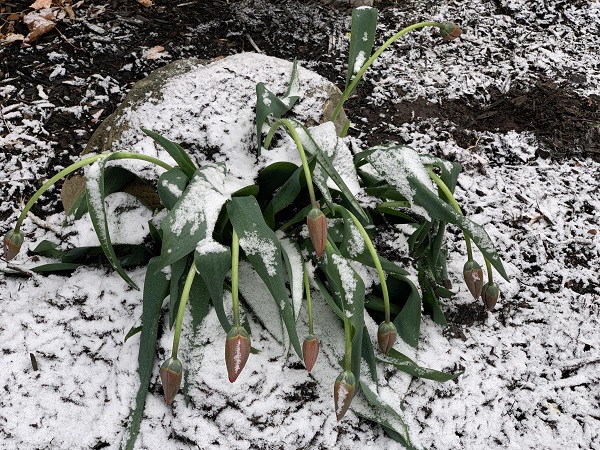
The snow also helps insulate the flowers but it can knock them down. Though they are resilient, the weight of the snow can break the flowers and unopened buds and cause them to droop. To keep the flowers upright, you can cover the tulips with huge bins or buckets.
Rain
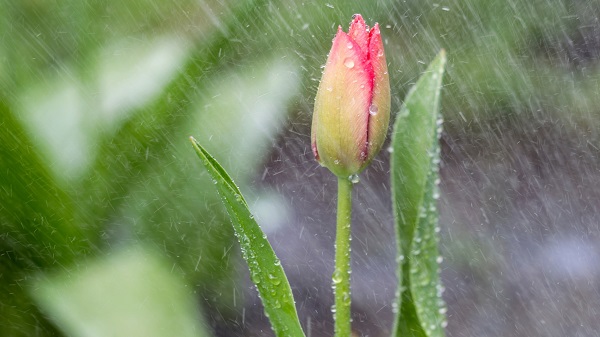
Rainy days are nature’s way of watering your tulips. So, if it rains, skip the watering routine and let them thrive on their own.
If you live in areas where rain is constant, your tulips might become prone to root rot. To solve the problem, you may consider growing them in containers or improving the water drainage of the soil.
What Are The Signs That You Overwatered Your Tulips? (and Can You Still Save Them?)
If in case you’re reading this and the damage has been done to your tulips, don’t fret. You still have a chance of reviving your overwatered tulips. Knowing about the life cycle of tulips can help you avoid watering them at the wrong time.
Here are some of the essential things that you should consider before pouring water onto the soil:
- Cold-loving tulips are dormant in summer. So, watering them when the summer heat is raging will cause overwatering issues. The water will not be absorbed by the plant, remain stagnant, breed fungal disease, or encourage rotting.
- Watering tulips after several days of rain can drown them.
- The soil is too clumpy and has poor draining, causing the tulip bulbs to drown.
Before we head on to the steps for recovery of tulips, it’s essential to know the signs of overwatering problems in tulips below:
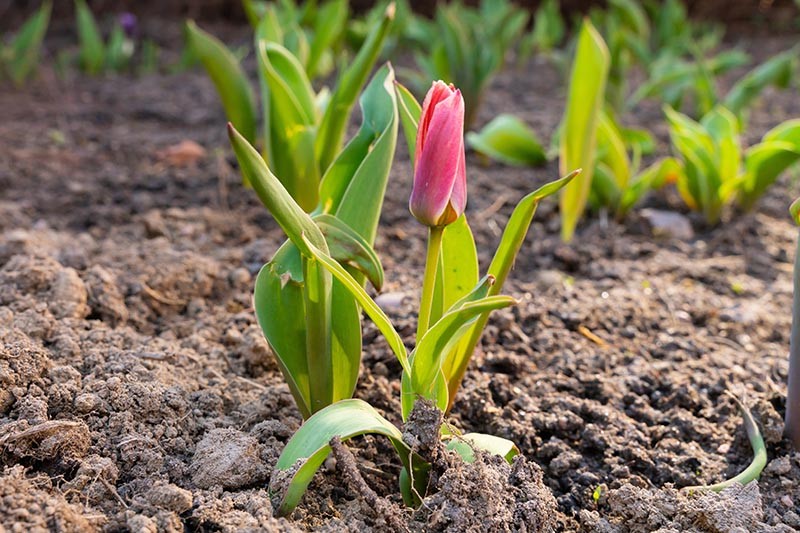
- Petals losing their vibrant colors: When there’s an overwatering issue, the roots are incapable of getting enough nutrients from the soil which causes the petals to lose their color and vigor.
- Leaves become soft and droopy: Due to too much water, you will notice that the crisp leaves became too mushy. That means the leaves are drowning in water and have nowhere to release it so they just bulge and become softer.
- Yellowing and browning leaves: Like the petals, leaves are also starving from nutrients due to a lack of supply from the roots that are drowned and suffocated.
- Rotting smell from the soil due to root rot: Worst cases of overwatering lead to bulb rot which emits a rotting smell from the soil. At this stage, the tulip plant can no longer be saved.
How To Treat Overwatered Tulip Plants?
If you mistakenly overwatered your tulips, there’s still hope of reviving them before they start rotting. Here are some of the steps that you can try:
- Mild cases – yellowing of leaves: For such cases, you have to stop watering the plant and add a few inches of mulch to help absorb the excess water in the soil. You should also add more drainage holes if the tulips are potted.
- Moderate to severe cases- limp leaves: If the leaves are soggy and the color of the flowers is becoming pale, the best option is to transplant the whole plant into a new area or pot. Ensure that the new location receives a lot of sunlight and has well-draining soil.
Fungal Diseases Caused By Overwatering Tulips
The excessive presence of moisture due to overwatering tulips can cause the following fungal diseases:
- Basal rot
- Fire disease
- Pythium root rot
- Stem and bulb nematode
- Blue mold
When your tulips are overwatered, they become weak which pathogens and other fungal infections will take advantage of.
So, at the first signs of yellow or mushy leaves, consider taking preventive measures before the pathogens get their way into the plant.
How To Water Cut Tulips in a Vase?
Not a lot of gardeners have the time and patience to force tulips indoors. The best thing about tulips is you can still enjoy their fragrant scent and admire their stunning flowers on a vase. You can simply cut the flowers and dip them in water. Here’s how:
Materials:
- Pruning shears
- Cold Water
- Vase
- Newspaper
Directions:
- Cut the tulips from the plant diagonally using your pruning shears.
- Cover the upper part of the flower with newspaper to serve as insulation.
- Dip the diagonal tip of the flower on a vase filled with coles water and let it sit for 1 to 2 hours. This method will help extend the life of your tulips in a vase.
- Once done, you can now remove the newspaper and keep the water level at about ⅔ of the vase.
If you add cold water to the vase, the flowers will remain crisp and upright for a week. The life of cut flowers can only last for 5 to 7 days and during that duration, you can keep them looking at their best through the help of cold water.
Did You Know? Tulips are generous plants. The moment you see them blooming and thriving, they are already giving birth to new bulbs in the soil. So, whenever the flowers are spent, do not remove the leaves because they will provide nutrients to the new generation of tulips underground.
Frequently Asked Questions (FAQs)
How often do you water tulips in pots?
Tulips are low maintenance and easy to grow. They need ⅔ of an inch of watering one or two times a week. Water them until it drips at the bottom of the pot.
Do tulips need a lot of water?
No. Tulips only need a subtle amount of moisture. Too much water can lead to root rot and the formation of fungal diseases.
Can you overwater tulips?
Yes. Most of the time tulips only need watering the moment they are planted to activate the bulb. After that, it can survive on its own. You may occasionally water them but it has to be less than an inch. Otherwise, the root may rot which is a common problem in growing tulips.
Should I water tulips in pots?
Yes. Pots and potting mixes for tulips are designed to drain faster to prevent root rot. For that reason, the soil also drains faster than in-ground soil which can lead to drought stress.
When you notice that the soil is too dry, water the tulips until you feel the moisture at the bottom of the pot.
Do tulips need a lot of sun exposure?
Tulips are tolerant of full sun and partial shade. Sunlight helps tulips produce bigger blooms and reach their optimal height. However, they cannot tolerate the harsh sun in warmer climates.
Can Tulips survive indoors?
Yes, but they are rarely grown inside the home. Tulips can survive indoors because they can grow in containers and are tolerant of partial shade.
However, they require long periods of cold to reset and bloom again in the next growing season. They also contain alkaloids that are toxic to pets and humans.
When should I start watering tulips?
Start watering tulips after planting them. Make sure that the growing medium is soaked to wake up the plants and start adjusting to their new home.
Then, keep watering them every week for the first month. They are low-maintenance so you can leave your tulips alone in the preceding months. When the warm season comes, check the moisture level in the soil and water them accordingly.
How often do tulips bloom indoors?
The bloom production of tulips depends if they are prepared or forced indoors during fall. Unlike other plants, tulips need to be at a cold temperature of 40 to 45 F for 12 weeks to bloom.
After that timeframe, you must keep them in a cool area around the house to help the shoots grow. After a month, the flowers will start to bloom. You can force the tulips to bloom again using another round of cold storage treatment.
How much water do tulips need in a vase?
Fill the vase with ⅔ of water to keep the tulips blooming from 5 to 7 days. They are not a fan of too much water so you have to keep it on a low level.
Final Thoughts
We hope that this post helped you have an idea of how you will water your tulip plants. It can be tricky at first but once you get to know how tulips grow and thrive, the process eventually becomes a no-brainer.
If you find this post helpful, please don’t forget to share it with your friends. Enjoy the beautiful blooms and captivating scent of tulips!
